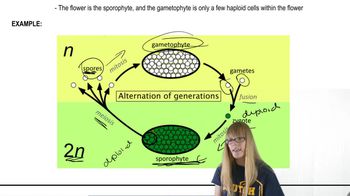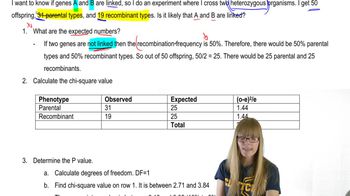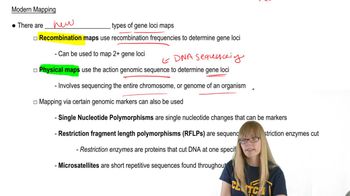Table of contents
- 1. Introduction to Genetics51m
- 2. Mendel's Laws of Inheritance3h 37m
- 3. Extensions to Mendelian Inheritance2h 41m
- 4. Genetic Mapping and Linkage2h 28m
- 5. Genetics of Bacteria and Viruses1h 21m
- 6. Chromosomal Variation1h 48m
- 7. DNA and Chromosome Structure56m
- 8. DNA Replication1h 10m
- 9. Mitosis and Meiosis1h 34m
- 10. Transcription1h 0m
- 11. Translation58m
- 12. Gene Regulation in Prokaryotes1h 19m
- 13. Gene Regulation in Eukaryotes44m
- 14. Genetic Control of Development44m
- 15. Genomes and Genomics1h 50m
- 16. Transposable Elements47m
- 17. Mutation, Repair, and Recombination1h 6m
- 18. Molecular Genetic Tools19m
- 19. Cancer Genetics29m
- 20. Quantitative Genetics1h 26m
- 21. Population Genetics50m
- 22. Evolutionary Genetics29m
4. Genetic Mapping and Linkage
Mapping Genes
Problem 31a
Textbook Question
A genetic study of an early onset form of heart disease identifies 10 families containing members with the condition. No clear dominant or recessive pattern of inheritance is evident, but an analysis of SNP markers for five families detects a strong association with a marker on chromosome 12, and genetic linkage analysis for the marker produces a lod score of 2.2.
What next step do you recommend for this genetic analysis?
 Verified step by step guidance
Verified step by step guidance1
<span>1. **Understand the LOD Score**: The LOD (Logarithm of the Odds) score is a statistical measure used in genetic linkage analysis to evaluate the likelihood that a particular trait is linked to a specific genetic marker. A LOD score of 2.2 suggests some evidence of linkage, but it is below the conventional threshold of 3.0, which is considered significant evidence of linkage.</span>
<span>2. **Consider Increasing Sample Size**: To strengthen the evidence for linkage, consider increasing the sample size by including more families or individuals in the study. This can help to achieve a higher LOD score and provide more robust evidence of linkage.</span>
<span>3. **Fine-Mapping the Region**: Perform fine-mapping of the region on chromosome 12 where the SNP marker is located. This involves analyzing additional markers in the region to narrow down the specific location of the gene or genes associated with the heart disease.</span>
<span>4. **Functional Studies**: Once a candidate region or gene is identified, conduct functional studies to understand the biological role of the gene and how mutations might contribute to the heart disease phenotype. This can involve in vitro studies, animal models, or other experimental approaches.</span>
<span>5. **Consider Other Genetic Factors**: Since no clear pattern of inheritance is evident, consider the possibility of a complex trait influenced by multiple genes and environmental factors. This may involve conducting a genome-wide association study (GWAS) to identify other potential genetic contributors.</span>
Recommended similar problem, with video answer:
 Verified Solution
Verified SolutionThis video solution was recommended by our tutors as helpful for the problem above
Video duration:
4mPlay a video:
Was this helpful?
Key Concepts
Here are the essential concepts you must grasp in order to answer the question correctly.
SNP Markers
Single Nucleotide Polymorphisms (SNPs) are variations at a single position in a DNA sequence among individuals. They are crucial in genetic studies as they can serve as markers for identifying genetic associations with diseases. In this context, the strong association of SNP markers with the heart disease suggests a potential genetic link that warrants further investigation.
Recommended video:
Guided course

Mapping with Markers
Lod Score
The lod score (logarithm of the odds) is a statistical measure used to evaluate the likelihood that two loci are linked, compared to them being unlinked. A lod score of 2.2 indicates a significant likelihood of linkage, suggesting that the marker on chromosome 12 may be associated with the early onset heart disease. This score helps guide researchers in determining the next steps in genetic analysis.
Recommended video:
Guided course

Formation of Plant Gametes
Genetic Linkage Analysis
Genetic linkage analysis is a method used to map genes by studying the co-segregation of traits and genetic markers within families. It helps identify regions of the genome that may contain genes associated with specific diseases. Given the findings from the SNP analysis and the lod score, further genetic linkage analysis could help pinpoint the exact location of the disease-causing gene.
Recommended video:
Guided course

Chi Square and Linkage
Related Videos
Related Practice





